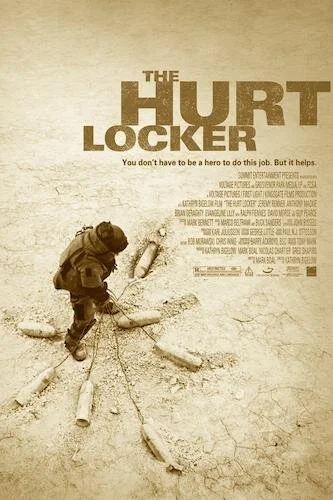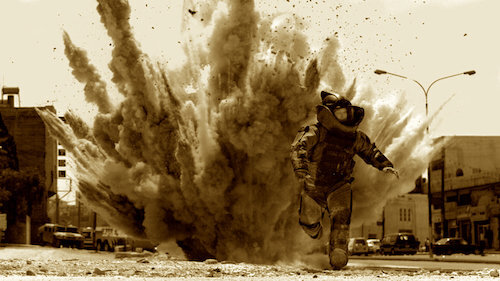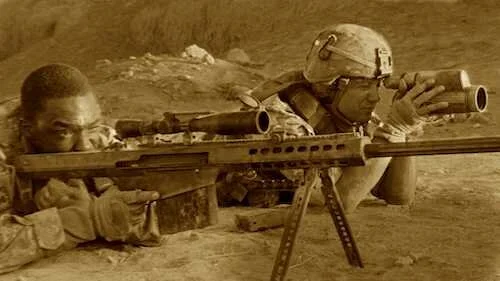The Hurt Locker
This review is a part of the Best Picture Project: a review of every single Academy Award winner for the Best Picture category. The Hurt Locker is the eighty second Best Picture winner at the 2009 Academy Awards.
The Academy finally went back to their old ways, by electing ten Best Picture nominees rather than just five. This rule would quickly change to being six-to-ten, depending on how many votes certain films received. For these Oscars, the idea was to bring up the ten best films of the year, like any standard journalist’s end-of-year list. With an overwhelming amount of Oscar buzz (including a couple of films that didn’t deserve it), there was a lot of hope shown here. An animated film like Up had a chance, plus an experiment like District 9. The spread was increased, and a whole variety of styles could be shown here. Well, we knew the winner would be some sort of a major achievement or a drama of some sort. We were right. The two heavy weights were James Cameron’s groundbreaking Avatar, and Kathryn Bigelow’s perfect The Hurt Locker. Bigelow’s ex-husband rounded up many tech awards, naturally, but Bigelow herself changed history, becoming the first female to win Best Director (and for having a Best Picture film directed by a woman win).
It absolutely deserved to win. I remember being a young cinephile, still in my undergraduate years, and wanting to become a film major (I was undecided at this point). The 2009 Academy Awards (for the 2008 films) was the first time I tuned in, and I wanted to see if I could keep up with the nominees for the next year (ironically, now I had ten Best Picture nominees the first year I attempt this). Because I wasn’t all that well versed in cinema, The Hurt Locker alluded me for months, considering it was released early enough in the year (2008 in film festival circuits, actually). I finally got around to viewing the trailer, after seeing it acclaimed online for so many months, and I felt like I blew it. The trailer gave away everything. You see the end of the trailer show Sergeant James pulling up a bunch of buried bombs, all connected by one thin thread of wire. That had to be the climax. I ruined it for myself by watching. Oh well. Time to put the Blu Ray I bought into the player anyway.
By having a bomb go off in the first scene, The Hurt Locker makes you anxious about every single subsequent mission, seeing as mostly anyone in this film is susceptible to being killed.
I was so wrong. That clip was within the earlier moments of the film, and The Hurt Locker refuses to let up at all. It only gets more and more harrowing. It truly is an exercise in remaining calm. I still find The Hurt Locker uncontrollably nerve wracking eleven years later (I have to remind myself that this is the year 2020 now). If the trailer left the second on-screen mission of Sergeant James for the end, how much more insane can the film get? Very. There is a little plot, but mainly a goal: survive the rotation. The majority of The Hurt Locker is about getting out alive. The rest is character building, and understanding who is on the bomb squad team fending for each others’ lives.
After Sergeant Thompson dies in the opening scene, the squad is then led by Sergeant James, who is a brilliant handler and disposer of explosives, but he has a wild side to him. Having served for many rotations, James is now one with war. He finds adrenaline in what he does, and others may find his methods careless (especially since they can’t control what he does, or how he does it). He is unprofessional, but there isn’t a sergeant that’s nearly as good as he is. So, The Hurt Locker becomes a game. How long can unit mates Sanborn and Eldridge cope with a dangerous leader, who is in charge of the fates of all around him? How far can dangerous tactics go, before a protector becomes a threat?
The EOD unit testing various explosives on a vacated site.
You learn a bit more about Eldridge’s traumas, and Sanborn’s familial dilemmas, either through cut away scenes, or Sergeant James trying to get to know these people. You can tell there are major reservations between squad mates, particularly because James plays by his own rules. This friction gets tested often. One particular moment is the sniper stand down sequence, where James has to be Sanborn’s eyes and spot an enemy shooter, while Sanborn patiently waits to make his kills. This moment takes a very long time, and you wait alongside two people that don’t get along watching each others’ backs. It’s a limbo that pulls you right in with complete dread.
Otherwise, we learn just how far James is willing to go. You’re possibly on board with him at first, because he gets the job done. However, The Hurt Locker exposes when James is clueless, and even reckless. His ideas or theories begin to collapse, and we are left in frightening positions, led by a man that quickly forgets that he can ever be wrong. As the missions keep going, we see fate being played with a little too much. Things go awry, and even shape the film up enough. For every result that is worse than the last one, we are reminded that the rotation is still not finished yet. How much more can we take?
Sanborn and James cooperating to survive.
Eventually, we finally get a glimpse of a world outside of combat, since all of The Hurt Locker has taken place in a war zone until the last act. We don’t spend it with the shaken up Eldridge, or the purified Sanborn. We spend it with James, who has absolutely no idea how to function outside of war. On a bomb site, he tosses his helmet off, rips off his bomb suit, and gets comfortable. In a grocery store, he is overwhelmed by what cereal he should get. He knows nothing about life back home, outside of the fact that he loves being a dad. We barely see this life, and we’re tossed right back into war one final time. James is now in a year long rotation, and he couldn’t be happier.
As a story, The Hurt Locker is impossible to pry away from, because of how richly written the three main characters are. You know less about a “plot” or a “hero’s journey” than you do about what each character is fighting for, and who is back home waiting for them. It’s a gamble that pays off greatly, since you grow attached to people that could die at any second, placing you on the battlefield. Now, as a cinephile, The Hurt Locker is pitch perfect. I’m not a war veteran, nor have I enlisted in any troop of any sort. I am aware of how absurdly incorrect The Hurt Locker is with its accuracy. These include formations that would never take place, calls that wouldn’t be made, protocol that doesn’t make sense, and more. Most of these decisions were likely made to benefit the story more than the film’s factual credibility. Just know that The Hurt Locker is outstanding as cinema, but (from what I know) sloppy as a representation of how EODs and modern military units work.
James awestruck in the middle of a grocery store.
I’m here for the film, and The Hurt Locker is one of the great thrilling experiences in twenty first century cinema. Kathryn Bigelow managed to strip her directing style to bare basics, and found a new way to tell a story her own way: through gritty modern political lenses. This partnership with writer Mark Boal started a streak of spectacular films that continues with the just-as-wonderful Zero Dark Thirty, and the criminally overlooked Detroit. Wrapping up the first decade of the new millennium, The Hurt Locker’s Best Picture win represented a turning point for the Academy, that was now embracing festival darlings (Slumdog Millionaire) and more minimalist works by well experienced filmmakers (Million Dollar Baby; the “million” theme is merely coincidental). The Hurt Locker is one of the least profitable Best Picture winners in history (it may actually still be the least, to be honest), but that no longer matters to how accoladed a film could be. Avatar broke box office records at the time, but The Hurt Locker was the far superior film, which continues to bowl over audiences to this day.
Andreas Babiolakis has a Masters degree in Film and Photography Preservation and Collections Management from Ryerson University, as well as a Bachelors degree in Cinema Studies from York University. His favourite times of year are the Criterion Collection flash sales and the annual Toronto International Film Festival.









